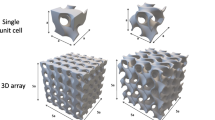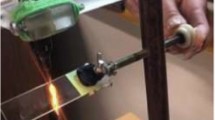Abstract
In inertial confinement fusion (ICF) experiments, the growth of hydrodynamic instability occurred at the layer-to-layer interface of multilayer capsule is of the main importance to obtain ignition and high gain. In order to investigate and simulate the growth of hydrodynamic instability at “SG II”laser facility, we designed and fabricated a multi-layered shock wave tube (MSWT) in this article. The MSWT consisted of four functional units: planar polystyrene (CH) film, Al film with perturbation patterns, polyimide (PI) plastic and cylindrical carbonized-resorcinol–formaldehyde (CRF) aerogel, which were assembled into a cylindrical CH tube. The design, preparation process and assembly process of MSWT were detailed described. The assembly deviations and packaging material were discussed.










Similar content being viewed by others
References
T.J.B. Collins et al., Phys. Plasmas 14, 056308 (2007)
J.A. Marozas et al., Phys. Plasmas 13, 056311 (2006)
P.P. Amendt, C. Cerjan, A. Hamza et al., Assessing the prospects for achieving double-shell ignition on the National Ignition Facility using vacuum hohlraums. Phys. Plasmas 14, 056312 (2007)
R. Ishizaki, K. Nishihara, J.G. Wouchuk, et al., Rippled shock propagation and hydrodynamic perturbation growth in laser implosion. J. Mater. Process. Technol. 85, 34–38 (1999)
S. Chandrasekhar, Hydrodynamic and Hydromagnetic Stability (Clarendon, Oxford, 1961)
R.D. Richtmyer, Commun. Pure Appl. Math. 13, 297 (1960)
B. Zhou, J. Wang, J. Shen et al., Surface perturbation target for the Rayleigh–Taylor instability in inertial confinement fusion experiments. J. Vac. Sci. Technol. A 17(6), 3516–3520 (1999)
J. Kilkenny, K. Shillito, J. Kaae, et al., Inertial confinement fusion targets. General Atomics report, 2005
N. Metzler, A.L. Velikovich, A.J. Schmitt et al., Laser imprint reduction with a short shaping laser pulse incident upon a foam-plastic target. Phys. Plasmas 9(12), 5050–5058 (2002)
M. Shukla, Y. Kashyap, P.S. Sarkar et al., Laser induced shock pressure multiplication in multilayer thin foil targets. Nucl. Fusion 46, 419–431 (2006)
C.C. Kuranz, R.P. Drake, M.J. Grosskopf et al., Three-dimensional blast-wave-driven Rayleigh-Taylor instability and the effects of long-wavelength modes. Phys. Plasmas 16, 056310 (2009)
J. Guo, F. Sizu, D. Jiaqin, et al. Experimental data processing on laser drive Rayleigh-Taylor instability. Chin. J. Lasers, 37(1) (2010)
D. Jiaqin, F. Sizu, X. Jun, et al. Experimental research on pinhole assisted point projection diagnostic scheme. Acta Optica Sinica 28(3) (2008)
Q. Sun, Z. Bin, H. Yao-dong et al., Study on figure transfer process and the preparation of surface perturbation target. At. Energ. Sci. Technol. 36(4/5), 327–330 (2002)
Q. Sun, Z. Bin, Y. Fan et al., Aluminium target with deep amplitude modulation fabricated by chemical wet etching process. High Power Laser Particle Beams 17(9), 1382–1386 (2005)
B. Hua Zhou, S.M. Mahdavian, Experimental and theoretical analyses of cutting nonmetallic materials by low power CO2-laser. J. Mater. Process. Technol. 146, 188–192 (2004)
A. Nikroo, K.C. Chen, M.L. Hoppe et al., Progress toward fabrication of graded doped beryllium and CH capsules for the National Ignition Facility. Phys. Plasmas 13, 056302 (2006)
R.W. Margevicius, Fusion Sci. Technol. 41, 286 (2002)
M.M. Marinak, S.G. Glendinning, R.J. Wallace et al., Nova indirect drive Rayleigh–Taylor experiments with beryllium. Phys. Plasmas 9, 3567 (2002)
J.A. Cobble, T.E. Tierney, N.M. Hoffman et al., Late-time radiography of beryllium ignition-target ablators in long-pulse gas-filled hohlraums. Phys. Plasmas 13, 056304 (2006)
G.A. Kyrala, M.M. Balkey, C.W. Barnes, et al. Target fabrication: a view from the users. Fusion Sci. Technol. 45 (2004)
Acknowledgments
This work was supported by National Natural Science Foundation of China (50802064, 50752001 and 11074189), New Century Excellent Talents in University of China (NECT-08-0405), National Science and Technology Support Program (2009BAC62B02) and Shanghai Committee of Science and Technology (0952nm00900).
Author information
Authors and Affiliations
Corresponding author
Rights and permissions
About this article
Cite this article
Zhu, X., Zhou, B., Xu, X. et al. Fabrication of Multi-layered Shock Wave Tube for Hydrodynamic Instability Experiment. J Fusion Energ 30, 509–515 (2011). https://doi.org/10.1007/s10894-011-9410-7
Published:
Issue Date:
DOI: https://doi.org/10.1007/s10894-011-9410-7




